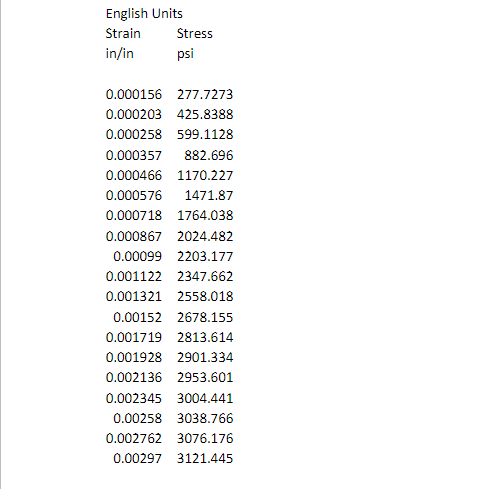Points for stress vs strain (in image) Assume the compressive concrete strength (f’c) is 3,000 lb/in2 (psi) Calculate a cubic function (3rd order polynomial – Ax3+Bx2+Cx+Constant) Use this function to create a function that describes the slope of the cubic function (the derivative of the cubic function). This new function allows you to calculate the tangent to any point along the curve. The tangent is the modulus of elasticity (E). The concrete code provides a formula to calculate E for concrete. That formula is: E = 57,000√??′, where f’c is in units of psi, and E is in units of psi. Use the derivative function you calculated to locate the point on the curve where the slope of the curve matches E using the concrete code formula. Express that stress point on the curve as a percentage of the compressive strength of the concrete. Now, calculate the secant modulus for the test case using 1,500 psi (50% f’c) as the arbitrary point on the curve. Assume fracture occurs at the last point (0.00297,2121.445). Calculate toughness. (Units are psi
Points for stress vs strain (in image) Assume the compressive concrete strength (f’c) is 3,000 lb/in2 (psi) Calculate a cubic function (3rd order polynomial – Ax3+Bx2+Cx+Constant) Use this function to create a function that describes the slope of the cubic function (the derivative of the cubic function). This new function allows you to calculate the tangent to any point along the curve. The tangent is the modulus of elasticity (E). The concrete code provides a formula to calculate E for concrete. That formula is: E = 57,000√??′, where f’c is in units of psi, and E is in units of psi. Use the derivative function you calculated to locate the point on the curve where the slope of the curve matches E using the concrete code formula. Express that stress point on the curve as a percentage of the compressive strength of the concrete. Now, calculate the secant modulus for the test case using 1,500 psi (50% f’c) as the arbitrary point on the curve. Assume fracture occurs at the last point (0.00297,2121.445). Calculate toughness. (Units are psi
Principles of Heat Transfer (Activate Learning with these NEW titles from Engineering!)
8th Edition
ISBN:9781305387102
Author:Kreith, Frank; Manglik, Raj M.
Publisher:Kreith, Frank; Manglik, Raj M.
Chapter5: Analysis Of Convection Heat Transfer
Section: Chapter Questions
Problem 5.2P: 5.2 Evaluate the Prandtl number from the following data: , .
Related questions
Question
Points for stress vs strain (in image)
Assume the compressive concrete strength (f’c) is 3,000 lb/in2 (psi)
Calculate a cubic function (3rd order polynomial – Ax3+Bx2+Cx+Constant)
Use this function to create a function that describes the slope of the cubic function (the derivative of the
cubic function). This new function allows you to calculate the tangent to any point along the curve. The
tangent is the modulus of elasticity (E).
Calculate a cubic function (3rd order polynomial – Ax3+Bx2+Cx+Constant)
Use this function to create a function that describes the slope of the cubic function (the derivative of the
cubic function). This new function allows you to calculate the tangent to any point along the curve. The
tangent is the modulus of elasticity (E).
The concrete code provides a formula to calculate E for concrete. That formula is:
E = 57,000√??′, where f’c is in units of psi, and E is in units of psi.
Use the derivative function you calculated to locate the point on the curve where the slope of the curve
matches E using the concrete code formula. Express that stress point on the curve as a percentage of
the compressive strength of the concrete.
E = 57,000√??′, where f’c is in units of psi, and E is in units of psi.
Use the derivative function you calculated to locate the point on the curve where the slope of the curve
matches E using the concrete code formula. Express that stress point on the curve as a percentage of
the compressive strength of the concrete.
Now, calculate the secant modulus for the test case using 1,500 psi (50% f’c) as the arbitrary point on
the curve.
Assume fracture occurs at the last point (0.00297,2121.445). Calculate toughness. (Units are psi)
the curve.
Assume fracture occurs at the last point (0.00297,2121.445). Calculate toughness. (Units are psi)

Transcribed Image Text:English Units
Strain
in/in
Stress
psi
0.000156 277.7273
0.000203 425.8388
0.000258 599.1128
0.000357 882.696
0.000466 1170.227
0.000576 1471.87
0.000718 1764.038
0.000867 2024.482
0.00099 2203.177
0.001122 2347.662
0.001321 2558.018
0.00152 2678.155
0.001719 2813.614
0.001928 2901.334
0.002136 2953.601
0.002345 3004.441
0.00258 3038.766
0.002762 3076.176
0.00297 3121.445
Expert Solution
This question has been solved!
Explore an expertly crafted, step-by-step solution for a thorough understanding of key concepts.
Step by step
Solved in 3 steps with 6 images

Knowledge Booster
Learn more about
Need a deep-dive on the concept behind this application? Look no further. Learn more about this topic, mechanical-engineering and related others by exploring similar questions and additional content below.Recommended textbooks for you

Principles of Heat Transfer (Activate Learning wi…
Mechanical Engineering
ISBN:
9781305387102
Author:
Kreith, Frank; Manglik, Raj M.
Publisher:
Cengage Learning

Principles of Heat Transfer (Activate Learning wi…
Mechanical Engineering
ISBN:
9781305387102
Author:
Kreith, Frank; Manglik, Raj M.
Publisher:
Cengage Learning